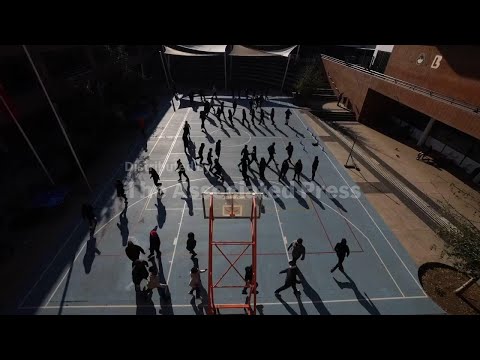(12 Sep 2025)
RESTRICTIONS SUMMARY
ASSOCIATED PRESS
Santiago, Chile – 08 September 2025
1. Various of students playing sports, ping pong, basketball in yard at Bicentenario School
2. Various of students entering school and putting their phones in isolation bags
3. SOUNDBITE (Spanish) Humberto Garrido, Principal of Bicentenario School:
“For the moment, I can tell you that there are results. After a month and a half, we have more focused students. There are no cell phones in the classroom. They have their devices, they are already used to handing them in, putting them away, and in the afternoon, they take them out themselves with a lock that magnetically disconnects them.”
4. Students practicing dance in school yard
5. Shadows of students
6. SOUNDBITE (Spanish) Francisca Susarte, 13-year-old student:
“When we had the cell phone in the box, I felt anxious about handing it over, so I didn’t hand it over because if it broke, I would lose it. Something would happen to it. That’s why I feel more comfortable with the cases now, because I have it, I take care of it, and it’s mine.”
7. Students playing soccer
8. SOUNDBITE (Spanish) Felipe Alessandri, Mayor of Lo Barnechea County:
“After the pandemic, because of the pandemic, so that they could continue their education, smartphone use became widespread. So we see six- and seven-year-old children with phones who are constantly hyperconnected, receiving stimuli that are not always appropriate for their age. And I think they realized that they were no longer interacting."
9. Students
ASSOCIATED PRESS
Santiago, Chile – 09 September 2025
++VIDEOCALL INTERVIEW++
10. SOUNDBITE (Spanish) Carolina Pérez, educator and author of the book ‘Secuestrados por las pantallas (Kidnapped by the screens)’:
“It must be clear that these devices have been designed to be addictive, and the sooner I start, the longer I will have my customer captive for life. So, all the scientific evidence says that for a smartphone to be used healthily, it has to be from the age of 16 onwards.”
ASSOCIATED PRESS
Santiago, Chile – 08 September 2025
11. Various of students leaving school and unlocking phone bags
STORYLINE:
Volleyball, basketball, ping pong, dancing rehearsals or simple chats.
Dozens of teens are rediscovering how to reconnect to the real world after a school in Santiago, Chile, implemented a pioneering program in the country that blocks cell phone signals.
Now, instead of compulsively scrolling through their Instagram feeds or sharing choreographed TikTok dances, students spend time at the library, the café or along the several courts of Lo Barnechea Bicentenario school, located in the wealthy district of Lo Barnechea in northern Santiago.
On a recent cold, sunny day at the end of winter in Chile, dozens of students patiently lined up before putting their smartphones inside a black case designed to jam signal detection through a blocking magnet that only can be deactivated by the school’s inspectors.
They are still able to keep their devices, but are only allowed to text, call or scroll again after school is over.
"After a month and a half, we have more focused students.” the school’s principal, Humberto Garrido, told The Associated Press.
The program — the first ever put in place in Chile and one of the first in South America — was implemented last month, a bid by the Lo Barnechea mayor’s office to address student well-being in times of hyperconnectivity and to help them rediscover real-world connections.
AP Video shot by Mauricio Cuevas
Find out more about AP Archive: http://www.aparchive.com/HowWeWork
Twitter: https://twitter.com/AP_Archive
Facebook: https://www.facebook.com/APArchives
Instagram: https://www.instagram.com/APNews/
You can license this story through AP Archive: http://www.aparchive.com/metadata/youtube/9aab9e138d094426964f1bf4a1d297ed
Author: AP Archive
Go to Source
News post in September 17, 2025, 6:04 am.
Visit Our Sponsor’s:
News Post In – News





